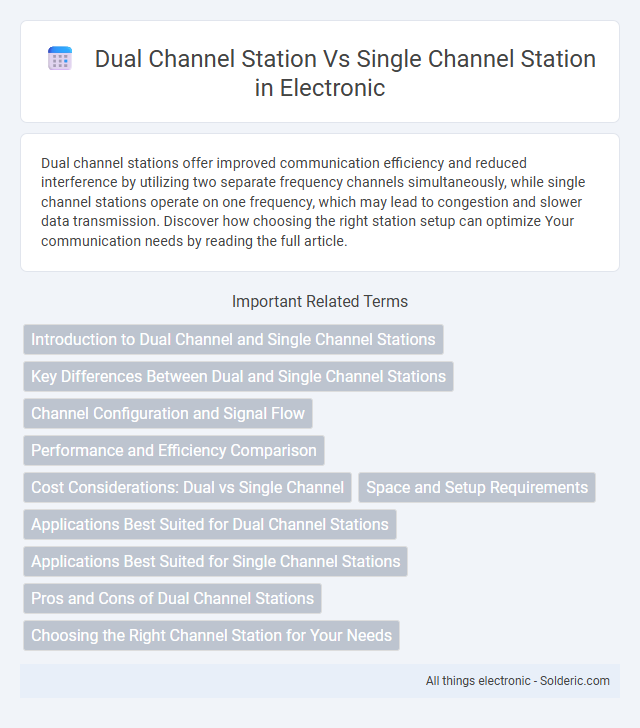Dual channel stations offer improved communication efficiency and reduced interference by utilizing two separate frequency channels simultaneously, while single channel stations operate on one frequency, which may lead to congestion and slower data transmission. Discover how choosing the right station setup can optimize Your communication needs by reading the full article.
Comparison Table
| Feature | Dual Channel Station | Single Channel Station |
|---|---|---|
| Channel Count | 2 Channels | 1 Channel |
| Data Throughput | Higher through parallel processing | Lower, single data stream |
| Redundancy | Improved fault tolerance | No redundancy |
| Complexity | More complex setup and maintenance | Simpler design and management |
| Cost | Higher initial investment | Lower cost |
| Use Case | High reliability and performance needs | Basic, low-cost applications |
Introduction to Dual Channel and Single Channel Stations
Dual channel stations use two separate frequency channels simultaneously to transmit and receive data, enhancing bandwidth and improving communication efficiency compared to single channel stations. Single channel stations operate on a single frequency channel, which can limit data throughput and increase the chances of signal interference or congestion. Dual channel technology is widely adopted in modern wireless networks to support higher data rates and more stable connections.
Key Differences Between Dual and Single Channel Stations
Dual channel stations operate with two simultaneous communication paths, enhancing data throughput and reducing latency, while single channel stations use only one path, limiting capacity and speed. The additional channel in dual setups provides improved reliability and better load balancing, crucial for high-demand applications. Single channel stations generally incur lower costs and simpler configurations but fall short in performance compared to their dual channel counterparts.
Channel Configuration and Signal Flow
Dual channel stations utilize two independent communication paths, allowing simultaneous data transmission and reception, which enhances overall throughput and reduces latency compared to single channel stations that operate with a single communication path. In dual channel configurations, signal flow is managed separately for each channel, enabling parallel processing and improved signal integrity by minimizing interference. Single channel stations combine transmission and reception into one path, often leading to sequential signal processing and potentially higher congestion or signal degradation under heavy data loads.
Performance and Efficiency Comparison
Dual channel stations offer significantly higher data transfer rates and improved bandwidth utilization compared to single channel stations, resulting in enhanced performance for demanding applications. The dual channel configuration reduces latency by allowing simultaneous data streams, which increases overall network efficiency and responsiveness. Your system benefits from better multitasking capabilities and smoother handling of large file transfers or streaming, making dual channel stations a superior choice for performance-oriented environments.
Cost Considerations: Dual vs Single Channel
Dual channel stations typically incur higher initial setup costs due to the need for additional hardware, infrastructure, and maintenance compared to single channel stations. Operating expenses can also be greater for dual channel systems because of increased power consumption and more complex network management requirements. However, the improved data throughput and redundancy in dual channel stations can provide better long-term value despite the higher upfront investment.
Space and Setup Requirements
Dual channel stations require more physical space due to the need for additional hardware components, including separate transceivers and antennas for each channel, compared to single channel stations that operate with a single transceiver setup. Setup complexity increases with dual channel stations as precise synchronization and configuration are essential to ensure optimal performance, whereas single channel stations involve simpler installation and fewer wiring requirements. The larger footprint and intricate setup of dual channel stations can impact site selection and maintenance considerations, especially in constrained or remote environments.
Applications Best Suited for Dual Channel Stations
Dual channel stations excel in environments requiring simultaneous, high-volume data transmissions such as industrial automation, smart grid communications, and advanced traffic management systems. These stations leverage parallel data streams to enhance bandwidth and reduce latency, making them ideal for real-time monitoring and control applications in manufacturing plants and large-scale IoT networks. The increased throughput and reliability of dual channel stations support critical infrastructure where continuous, uninterrupted connectivity is essential for operational efficiency.
Applications Best Suited for Single Channel Stations
Single channel stations excel in applications requiring simple, cost-effective communication setups such as small businesses, retail stores, and emergency response teams. They offer reliable, straightforward radio coverage without the complexity of managing multiple channels, making them ideal for environments with minimal communication traffic. Industries with limited coordination needs benefit from single channel stations due to their ease of deployment and maintenance.
Pros and Cons of Dual Channel Stations
Dual channel stations improve data throughput and reduce latency by allowing simultaneous transmission on two channels, enhancing communication efficiency in high-demand environments. However, they require more complex hardware and increased power consumption, leading to higher operational costs and potential interference issues. Single channel stations offer simpler design and lower costs but may suffer from limited bandwidth and slower data rates.
Choosing the Right Channel Station for Your Needs
Selecting the right channel station depends on your specific broadcasting or communication requirements, where dual channel stations offer simultaneous transmission on two frequencies, enhancing coverage and redundancy. Single channel stations provide a focused, often more cost-effective option ideal for targeted communication or simpler setups. Evaluating your operational demands, budget, and desired range will help determine if a dual channel station's flexibility or a single channel station's simplicity best suits your needs.
dual channel station vs single channel station Infographic

 solderic.com
solderic.com